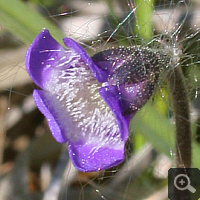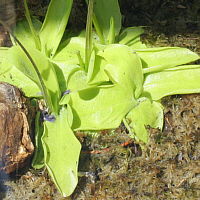Butterwort (Pinguicula)
Overview
The genus from the bladderwort family is widespread with circa 90 species in the whole northern hemisphere. Butterworts are (apart from a few species) perennial, rosette-building species. The leaves are between a few to almost 30 centimetres long and mostly rotund, less frequent elongated to filiform. Mostly pink to purple violet-like flowers are produced. Other flower colours are rare. Main distribution area is Mexico, most species there are heterophyll plants, produce succulent hibernal leaves therefore. In the tropical and subtropical regions exist in addition some homophyll butterworts with only one leaf shape throughout the year. Furthermore exist a whole series of species from the temperate zones, which are partly very frost-hardy. Also here exist homophyll and heterophyll plants.
Main groups
1. temperate, heterophyll Pinguiculae: Frost-hardy species, which build a winter bud, as with: Pinguicula alpina, Pinguicula grandiflora or Pinguicula vulgaris
2. temperate, homophyll Pinguiculae: Not or only slight frost-hardy species, which build no winter bud, as with: Pinguicula lusitanica or Pinguicula lutea
3. subtropical – tropical, heterophyll Pinguiculae: The most Mexican species. Not cold-compatible, but in winter is a small rest rosette built, as with: Pinguicula gypsicola or Pinguicula moranensis
4. subtropical – tropical, homophyll Pinguiculae: Butterworts of tropical origin with only one leaf shape, as with: Pinguicula emarginata or Pinguicula lignicola
Trap mechanism
The principle trap mechanism was already detailed described on the previous site. On the leaf surface are located on the one hand short-stalked tentacles, in addition non-stalked glands. The capture mucus, which is based on a polysaccharide solution, is secreted by the tentacles. Butterworts produce a number of enzymes, wherewith the prey, which consist first and foremost of small flies, are digested. The cleavage products are reabsorbed by sessile glands. Butterworts class among the active flypaper traps. Admittedly the tentacles are immobile, but it exists a more or less distinct ability to a movement of the leaf. Sometimes this ability is only marginal marked and at best a slight dent of the leaf is to be found in the area of the prey, so that this swims in a mere of enzyme-rich digestion liquid. But in addition exist also species, which show especially at the leaf margin region a more distinct leaf mobility.
Culture and propagation
Culture and propagation of the main groups
1. temperate, heterophyll Pinguiculae: These species are to be found in regions with frosty winters. In summer humid, rather cool, sunny to half-shady locations are favoured. The soils are rather mineral-rich and neutral to even basic. The ideal location is outdoors within a bog bed. However, attention should be paid to the fact that these species have problems with an acidic bog bed, furthermore they do not want to stand as soaky as many others outdoor carnivorous plants. Best is thus a keeping in a fen bed or in a bog pot with a mixture of peat, sand and some loam. The plants can also spend winter outdoors. A covering with leaves is only in the case of sensitive species necessary. In winter are furthermore numerous gemmae at the base of the winter bud produced, from which you can raise easily new plants in spring. Simply lay the gemmae on moist peat for propagation.
2. temperate, homophyll Pinguiculae: This group originates also from regions which have a summer and a winter. In winter obtains, however, no or only very slight frost. A real winter bud is just as little produced as gemmae. These species are in culture distinct more difficult as temperate, heterophyll Pinguiculae. Same keeping conditions obtain in summer. However, the plants should not be planted out, because they must be kept indoors during winter. Overwintering is in this plant group the basic difficulty. Required is a light and cool as well as humid location. The plants are to keep only slight moist.
3. subtropical – tropical, heterophyll Pinguiculae: By far, this group is the simplest to be kept. To this group belong most of the Mexican species, lots of them can absolutely be rated as novice plants. In summer they can be kept on the windowsill in a slight permanent ebb and flood irrigation system in a mixture of peat and sand. During German winter obtains at the natural site a dry period, so that only very small, succulent leaves are produced. In this time the plants should to be kept some cooler and more arid, but still light. A propagation by sowing is possible but time consuming. Substantial more efficient is a propagation by cuttings. Best for that are suitable succulent leaves, which are to break out with some of the white part from the base. The leaves can now either be laid on moist peat flat and slight pressed on or simply be given in a pot with some rainwater. Relative quickly mostly several small young plants form primarily in the range of the base, but also partly on the whole leaf, which you can later – as soon as the leaf has decomposed to the greatest extent – separate with a razor blade.
4. subtropical – tropical, homophyll Pinguiculae: This group is in many ways heterogeneous. They have in common that they need all-the-year the same culture conditions and that they form only one leaf shape. Concerning the origin, the culture conditions and the difficulties obtain distinct differences though. On the one hand belong to this group very simple species as Pinguicula emarginata, which can be cultivated on peat throughout the year warm (partly on the windowsill). On the other hand is to be found in this group also a Pinguicula filifolia, a species only for experts.
A propagation can take place by sowing or cuttings.


